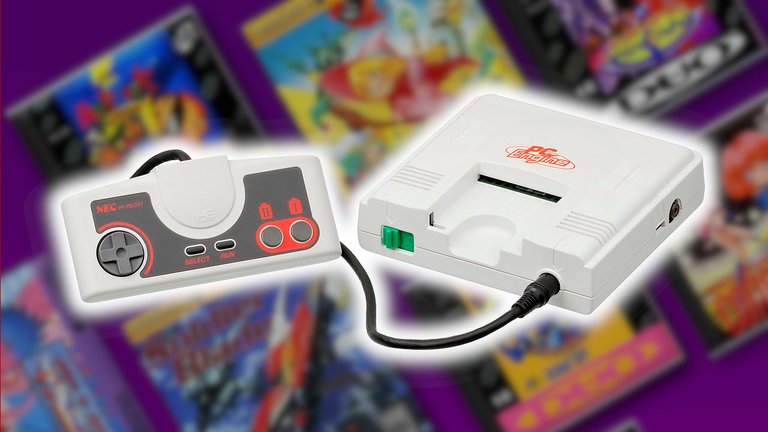Lesser Known 4th Generation Video Game Consoles - Trivia Tuesday #16
The 4th Generation of Game Consoles, Also called the 16-bit era was huge. It began in 1987 and succeeded the 8-bit generation. It brought out many technical advances to the industry, and whole new genres of games!

Popular 4th Generation Consoles
The main competition in the 4th generation was between the Super Nintendo Entertainment System (SNES) and SEGA Genesis. The competition was fierce as both consoles cultivated their fanbases and heavily promoted their Mascots: Mario and Sonic.
A peripheral that took advantage of CD-ROMs released for SEGA Genesis, which allowed for games with bigger storage, FMV support, and higher quality audio.
Nintendo partnered with SONY to make a CD-ROM adapter for SNES but their partnership fell short leading to Nintendo choosing Cartridges for their next console, and SONY entered the competition in the fifth generation.
Lesser Known
TurboGrafx-16
Also known as PC-Engine. Released in 1987 in Japan and 1989 in North America. Despite being a 16-bit era console, it featured an 8-bit processor unit. Many innovative games were released for the Console. Still, it didn't reach a comparable market to the SNES and SEGA Genesis.
TurboGrafx also had a CD-ROM peripheral that allowed for higher-quality games to be played on the system.
NEO GEO
NEO GEO was a ROM-cartridge-based console by SNK. It was their first system of the NEO GEO line, and featured multiple games. Mainly the ones developed by SNK like Samurai Showdown and Fatal Fury.
It's the first console to feature a removable memory card for game saves.
Others
The 3DO Multiplayer I mentioned in my article about the 5th generation consoles, seems to be closer to the timeline of the 4th generation. (Thanks ChatGPT.) There's also the CD-i and the Commodore CDTV according to Wikipedia. I may do a deep dive on these in the future.
Handheld Systems
The fourth generation is when Handheld gaming devices became common. The GameBoy was the leading handheld in this generation, beating out Atari Lynx and SEGA Game Gear, two handhelds that overshadowed it in terms of performance.
What do you think?
I thought there were more than these consoles in the 4th generation, but I enjoyed learning about NEO GEO and PC Engine for this article. I only heard about them in the emulation space, and for some reason, I want to see what are their games are like. Time to watch a few videos on Youtube.
Thanks for Reading!
If you have an idea for the next Trivia Tuesday's Topic, suggest it in a comment below. For now, have a nice day/night.~
- Images in this post are made using ibisPaint.
- People who supported me on HIVE, @master-lamps, @eturnerx and @magnacarta share 7% of this post's rewards.
Posted Using InLeo Alpha

16-bit era-- that's what we called the 4th Generation of gaming consoles back then. Super Nintendo and Sega Genesis were the market leaders back then. Mario Brothers was already a household name, and Sonic the Hedgehog premiered with the Sega Genesis. At the time I thought the Sonic mascot was a joke, but he's lasted to this day.
In the early 1990s I worked in retail and sold these consoles along with computer software and systems. Besides SNES and Genesis (not to mention Nintendo Game Boy and Sega Game Gear handheld units), we also sold NEC Turbo Grafx consoles (along with the CD-ROM perepheral).
These were more expensive in comparison, but people bought them occasionally. At one point, we even sold NeoGeo consoles and games; these were very expensive, and the cartridges were about the size of a baby's head; they were huge! If we sold 1 a year that was a lot.
Despite selling Commodore Amiga 500 computers, we did not sell Commodore CDTV or CD-i. At the time I wasn't aware of them, and the Commodore C64 section of software was dwindling by the day. 3DO consoles were unknown to be in those days.
I remember hearing about Atari Lynx, but I hadn't seen any. When I was working in retail, the Game Boy still had monochromatic LCD screens while the Game Gear was living color.
I may know about the 8-bit systems, but not as much as I know about the 16-bit systems.
Wow, that would be a scene to witness!!
I'm happy that you shared this personal story with us. Have some 🍕 !PIZZA with 💞 !LUV for your comment!
magnacarta, ahmadmanga sent you LUV. 🙂 (2/10) tools | trade | connect | wiki | daily
Made with LUV by crrdlx.
The PC Engine was known as the TurboGrafx-16 in North America. It was fairly popular but only for a relatively short time compared to the Genesis and Super NES. However, it was hugely popular in Japan. The Neo Geo was just too expensive for most people though it was around for a really long time.
I can see how successful the TubroGrafx was just from the loyal fans for it I see on youtube, though it's nothing compared to SNES and Genesis, hence the "lesser known."
Have some 🍕 !PIZZA with 💞 !LUV for your comment!
darth-azrael, ahmadmanga sent you LUV. 🙂 (1/10) tools | trade | connect | wiki | daily
Made with LUV by crrdlx.
$PIZZA slices delivered:
ahmadmanga tipped darth-azrael
@ahmadmanga(2/15) tipped @magnacarta
Congratulations @ahmadmanga! You received a personal badge!
Wait until the end of Power Up Day to find out the size of your Power-Bee.
May the Hive Power be with you!
You can view your badges on your board and compare yourself to others in the Ranking
Check out our last posts: